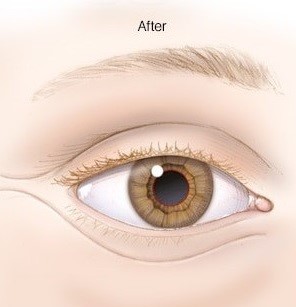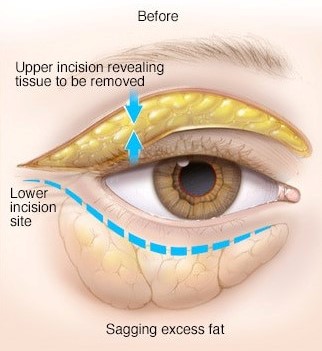

Blepharoplasty :
How blepharoplasty is done
Blepharoplasty is a type of surgery that repairs droopy eyelids and may involve removing excess skin, muscle and fat.
Besides making you look older, severely sagging skin around your eyes can reduce your side vision (peripheral vision
Alongside with skin and fat sagging upper eyelids can drop symmetrically or asymmetrically, which is called ptosis.
Why it’s done
your upper eyelids can improve your vision. Upper and lower lid blepharoplasty can make your eyes appear younger and more alert.
Blepharoplasty may be an option if you have:
- Baggy or droopy upper eyelids
- Excess skin of the upper eyelids that interferes with your peripheral vision
- Excess skin on the lower eyelids
- Bags under your eyes
You may undergo blepharoplasty at the same time as another procedure, such as a brow lift, face-lift or skin resurfacing and ptosis repair
Risks
Possible risks of eyelid surgery include:
- Infection and bleeding
- Dry, irritated eyes
- Difficulty closing your eyes or other eyelid problems
- Noticeable scarring
- Injury to eye muscles
- Skin discoloration
- The need for a follow-up surgery
- Temporarily blurred vision or, rarely, loss of eyesight
- Risks associated with surgery in general, including reaction to anaesthesia and blood clots
Talk to your doctor about how surgical risks apply to you. Understanding what is involved in blepharoplasty and weighing the benefits and risks can help you decide if this procedure is a good option.
How you prepare
- Your medical history. about your use of medications, vitamins, herbal supplements, alcohol, tobacco and drugs.
- Your expectations.
Before your eyelid surgery, you’ll undergo:
- A physical examination.Your surgeon will conduct a physical examination, which may include testing your tear production and measuring parts of your eyelids.
- A vision examination.Your eye doctor will examine your eyes and test your vision, including your peripheral vision. This is needed to support an insurance claim.
- Eyelid photography
And you’ll be asked to:
- Stop taking warfarin (Coumadin, Jantoven), aspirin, ibuprofen (Advil, Motrin IB, others), naproxen sodium (Aleve, others), naproxen (Naprosyn), and any other medication or herbal supplement associated with increased bleeding
- Quit smoking several weeks before your surgery. Smoking can reduce your ability to heal after surgery.
- Arrange for someone to drive you to and from surgery if you’re having outpatient surgery. Plan to have someone stay with you for the first night after returning home from surgery.
What you can expect
After the procedure
After surgery you spend time in a recovery room, where you are monitored for complications. You can leave later that day to recuperate at home.
After surgery you may temporarily experience:
- Blurred vision from the lubricating ointment applied to your eyes
- Watering eyes
- Light sensitivity
- Double vision
- Puffy, numb eyelids
- Swelling and bruising similar to having black eyes
- Pain or discomfort
Results
Bruising and swelling generally subside in 10 to 21 days, which may be when you feel comfortable going out in public again. Scars from the surgical cuts may take months to fade. Take care to protect your delicate eyelid skin from too much sun exposure.